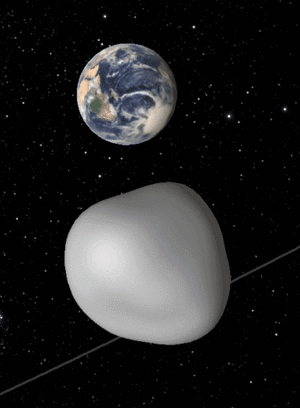For the last couple of days, there has been some news coverage of another small asteroid that’s going to fly close to the Earth tonight. This happens fairly often, although it is a little unsettling when it does. We have just passed the 9th anniversary of the discovery of a small asteroid that was on a collision course with Earth in October 2008. That object produced a fresh field of meteorites in Sudan.

The new asteroid 2012 TC4, was discovered on October 4th, 2012. It flew past Earth on October 12th of that year, 96,000km away. It’s only 13 meters across, and small asteroids like it and the other one tend to be discovered only when they are close enough to the Earth to be visible in large telescopes. Because the orbit of 2012 TC4 is tangent to the orbit of the Earth in October, the only time during the year when Earth and TC4 can be close together is in October. Since that 2012 encounter, the period of TC4’s orbit has been 1.67 years, so we are bound to be close together again after a five-year interval.
After this evening’s encounter, when only 43,000km will separate Earth and TC4, the period of its orbit will be lengthened to 2.06 years. The asteroid orbit will still be tangent to Earth’s orbit in October, and that extra 0.06 of a year will accumulate and may put the asteroid back close to Earth in October 2033 or 2050.
The way Starry Night simulates asteroid orbits in a conventional way depends on those orbits not changing very much. The Keplerian orbital elements model just requires six numbers that describe the orbit of an asteroid around its parent body. Starry Night models these numbers with an accuracy of up to 7 decimal places, and that’s accurate enough to describe asteroids in most of interplanetary space. Keplerian orbits do not simulate the way the Earth’s gravity can deflect the orbit of an asteroid around the Sun, and any asteroid that passes really close to the Earth will be deflected in that way. So the best way for us to simulate TC4’s encounter with Earth in SciDome is unconventional.
Simulating TC4 on SciDome
I have prepared a “Space Missions” file, composed of a set of state vectors from the JPL website that describe TC4’s path for the 8-day period centered on this week’s encounter. It accurately models the way TC4 will sneak as close to Earth as the belt of geosynchronous satellites, and the orbit should be accurate to 0.1km and about 10 seconds in time.
The space missions dataset, and the JPL data format that can make data for it, are originally meant to simulate spacecraft, not asteroids, but the way the data is presented is mostly the same. Although if you “fly to” TC4 in Starry Night, it will look like a space probe and not an asteroid.
If you have a recently updated SciDome, you can get 2012 TC4 on your dome by downloading this zip file, opening it up, then installing “2012 TC4.xyz” on your Preflight computer at the following folder location:
C:\Program Data\Simulation Curriculum\Sky Data\Space MissionsIt may be necessary to create a “Space Missions” folder in Sky Data here. If it is, it should be named just so.
If you have an older SciDome, the destination folder for the new file is a little different. Please contact me for directions.
With that done, the next time you run SciDome V7, you ought to be able to find 2012 TC4 by typing it into the search engine field at the top of the pane you choose to use as your “Find” pane. The “Celestial Path” or “Local Path” can be highlighted to show its course across Earth skies, and its “Mission Path” can be highlighted to represent its three-dimensional path through space around the Earth. The position of TC4 will only be simulated during the current 8-day period. If interest in it persists, its new orbit ought to be stable enough to represent with Keplerian elements after everything settles down.
TC4 will be passing through the constellations Aquarius, Capricornus and Sagittarius this evening. I used the JPL data to set up a prediction and make a reservation to use a 150mm online telescope in New Mexico tonight to try and take some images of TC4 as it passes by. We’ll see how it goes. Please feel free to contact me if you would like a little more guidance on installing 2012 TC4 on your SciDome.
